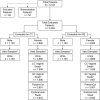Evaluation of the Performance of the Cobas CT/NG Test for Use on the Cobas 6800/8800 Systems for Detection of Chlamydia trachomatis and Neisseria gonorrhoeae in Male and Female Urogenital Samples
- PMID: 30651389
- PMCID: PMC6440774
- DOI: 10.1128/JCM.01996-18
Evaluation of the Performance of the Cobas CT/NG Test for Use on the Cobas 6800/8800 Systems for Detection of Chlamydia trachomatis and Neisseria gonorrhoeae in Male and Female Urogenital Samples
Abstract
The clinical performance of the Cobas CT/NG assay on the Cobas 6800/8800 systems (Cobas) for the detection of Chlamydia trachomatis and Neisseria gonorrhoeae was established in a multisite, prospective collection study using male and female urogenital specimens; supportive data from archived specimens were also included. The results obtained with the Cobas assay were compared with the patient infected status derived from a combination of U.S. Food and Drug Administration-approved nucleic acid amplification tests to determine the sensitivity and specificity of detection from each sample type. The sensitivity of Cobas for the detection of C. trachomatis in female specimens was 95.6% (95% confidence interval [CI], 92.4% to 97.4%) for urine; 98.6% (95% CI, 95.2% to 99.6%) and 99.2% (95% CI, 95.4% to 99.9%) for clinician- and self-collected vaginal swab specimens, respectively; 93.3% (95% CI, 89.6% to 95.7%) for endocervical swabs; and 92.5% (95% CI, 88.7% to 95.1%) for cervical swab samples in PreservCyt. The specificity for the detection of C. trachomatis was ≥98.8% for all female sample types. Sensitivity and specificity estimates of Cobas for the detection of C. trachomatis in male urine samples were 100% (96.8% to 100.0%) and 99.7% (95% CI, 99.2% to 99.9%), respectively. The sensitivity of Cobas for the detection of N. gonorrhoeae in female specimens was 94.8% (95% CI, 89.6% to 97.4%) for urine; 100.0% (95% CI, 87.9% to 100.0%) and 100.0% (95% CI, 87.9% to 100.0%) for clinician- and self-collected vaginal swab specimens, respectively; 97.0% (95% CI, 91.5% to 99.0%) for endocervical swabs; and 96.6% (95% CI, 90.6% to 98.8%) for cervical samples in PreservCyt; the specificity for all female sample types was >99.0%. The sensitivity and specificity of Cobas for detecting N. gonorrhoeae in male urine were 100.0% (95% CI, 95.8% to 100.0%) and 99.5% (95% CI, 98.8% to 99.8%), respectively. Fully automated assays help fill the clinical need for a sensitive, high-throughput screening tool to aid public health efforts to control C. trachomatis and N. gonorrhoeae infections.
Keywords: Chlamydia trachomatis; Cobas CT/NG assay; Neisseria gonorrhoeae; PCR; genital infection; molecular diagnostics; nucleic acid amplification test; sexually transmitted infection.
Copyright © 2019 Van Der Pol et al.
Figures



Similar articles
-
Detection of Chlamydia trachomatis and Neisseria gonorrhoeae with the cobas CT/NG v2.0 test: performance compared with the BD ProbeTec CT Qx and GC Qx amplified DNA and Aptima AC2 assays.Sex Transm Infect. 2019 Mar;95(2):87-93. doi: 10.1136/sextrans-2018-053545. Epub 2018 Aug 20. Sex Transm Infect. 2019. PMID: 30126947 Free PMC article.
-
Vaginal swabs are the optimal specimen for detection of genital Chlamydia trachomatis or Neisseria gonorrhoeae using the Cobas 4800 CT/NG test.Sex Transm Dis. 2013 Mar;40(3):247-50. doi: 10.1097/OLQ.0b013e3182717833. Sex Transm Dis. 2013. PMID: 23407470 Clinical Trial.
-
Comparison between the LCx Probe system and the COBAS AMPLICOR system for detection of Chlamydia trachomatis and Neisseria gonorrhoeae infections in patients attending a clinic for treatment of sexually transmitted diseases in Amsterdam, The Netherlands.J Clin Microbiol. 2001 Mar;39(3):829-35. doi: 10.1128/JCM.39.3.829-835.2001. J Clin Microbiol. 2001. PMID: 11230391 Free PMC article.
-
Systematic review: noninvasive testing for Chlamydia trachomatis and Neisseria gonorrhoeae.Ann Intern Med. 2005 Jun 7;142(11):914-25. doi: 10.7326/0003-4819-142-11-200506070-00010. Ann Intern Med. 2005. PMID: 15941699
-
Cobas® 4800: a fully automated system for the detection of Chlamydia trachomatis and Neisseria gonorrhoeae.Expert Rev Mol Diagn. 2013 Mar;13(2):131-40. doi: 10.1586/erm.12.141. Expert Rev Mol Diagn. 2013. PMID: 23477553 Review.
Cited by
-
Addressing Challenges in Chlamydia trachomatis Detection: A Comparative Review of Diagnostic Methods.Medicina (Kaunas). 2024 Jul 30;60(8):1236. doi: 10.3390/medicina60081236. Medicina (Kaunas). 2024. PMID: 39202518 Free PMC article. Review.
-
Impact of improper sample handling on Cobas CT/NG testing platform with dual swab sample collection kit for detecting Chlamydia trachomatis and Neisseria gonorrhoeae.Microbiol Spectr. 2024 Jan 11;12(1):e0322423. doi: 10.1128/spectrum.03224-23. Epub 2023 Dec 4. Microbiol Spectr. 2024. PMID: 38047699 Free PMC article.
-
Accuracy of self-collected versus healthcare worker collected specimens for diagnosing sexually transmitted infections in females: an updated systematic review and meta-analysis.Sci Rep. 2024 May 7;14(1):10496. doi: 10.1038/s41598-024-61358-y. Sci Rep. 2024. PMID: 38714714 Free PMC article.
-
Clinical evaluation of two commercial PCR kits for the detection of nonviral sexually transmitted infections.J Med Microbiol. 2025 Jul;74(7):002037. doi: 10.1099/jmm.0.002037. J Med Microbiol. 2025. PMID: 40605691 Free PMC article.
-
At-home specimen self-collection as an additional testing strategy for chlamydia and gonorrhoea: a systematic literature review and meta-analysis.BMJ Glob Health. 2024 Aug 27;9(8):e015349. doi: 10.1136/bmjgh-2024-015349. BMJ Glob Health. 2024. PMID: 39191483 Free PMC article.
References
-
- Newman L, Rowley J, Vander Hoorn S, Wijesooriya NS, Unemo M, Low N, Stevens G, Gottlieb S, Kiarie J, Temmerman M. 2015. Global estimates of the prevalence and incidence of four curable sexually transmitted infections in 2012 based on systematic review and global reporting. PLoS One 10:e0143304. doi:10.1371/journal.pone.0143304. - DOI - PMC - PubMed
-
- Centers for Disease Control and Prevention. 2018. Sexually transmitted disease surveillance 2017. U.S. Department of Health and Human Services, Atlanta, GA.

